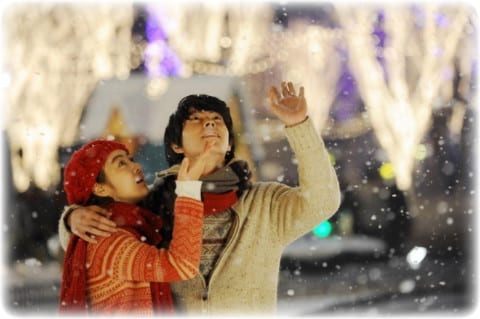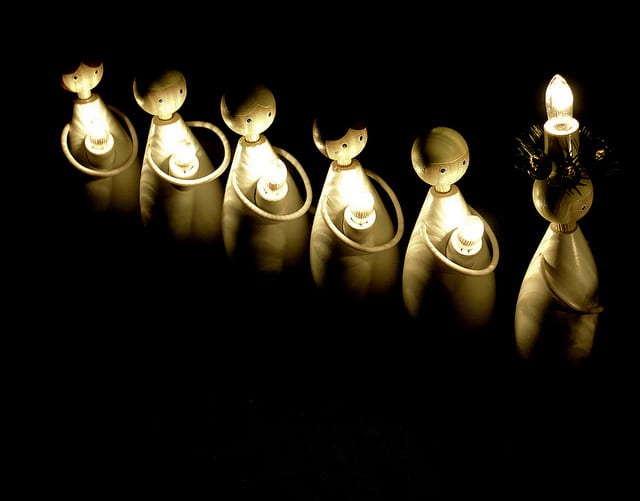TradOnline celebrates diversity this holiday season with a few accounts of what Christmas and New Year’s celebrations mean. Whether focused on religion or romance and friends, the winter holidays have many meanings around the world… A few things stay the same no matter where we come from: the holidays bring us together with our loved ones, and they are a time for indulging in both food and partying!
 Korea: party, romance and sharing!
Korea: party, romance and sharing!
For Koreans, Christmas is not a stay-at-home-with-the-family kind of holiday, like in France. It’s true that children wait for Father Christmas for their gift, but apart from this, it’s not the custom to spend the day with family. Christians usually go to mass while those of other faiths throw parties, exchange gifts, and as for couples, they often spend a romantic evening together. As Christmas is at the end of the year, people often throw a 2-in-1 party: Christmas and New Year’s! It is also a time when we think of those less fortunate, and of ways in which we can help them.
In short for Koreans, Christmas means partying (often with friends), romance, and caring for others!
Ji-Young Hamayon
Russia: the old, the new, the food!
In Russia, the biggest holiday of the year is the New Year’s Eve. Russians celebrate Christmas, too, but on the 7th of January, because the Russian Orthodox Church uses the old Julian calendar. That’s why we are lucky to have about 10 days of official holidays which usually last from January 1 to 10. We also have a bizarre holiday called the “Old New Year”, which is an informal traditional holiday, celebrated as the start of the New Year by the Julian calendar. Now it falls on January 14 in the Gregorian calendar, and many people celebrate it, too.
How do Russians spend their holidays? Of course, we put up a New Year’s tree and decorate it with beautiful toys: bright glass balls, stars, figures of birds and animals, sweets and lights. On the day of the New Year’s Eve we cook an enormous amount of tasty food — enough to last for a week or more – including many weird dishes like “Herring under fur coat” (a salad with herring, potatoes, grated beets and mayonnaise) and “Meat jelly”. You can watch this video to get an idea about what these typical dishes taste like to Americans:
Two figurines are usually placed under the fir tree: Grandfather Frost wearing a long blue or red fur coat, a matching hat and felt boots, and his granddaughter, Snow Maiden, also in a fur coat and with a long blond braid. These two magic people sometimes visit kids just before midnight. It might turn out that Grandfather Frost has suspiciously familiar eyes and the Snow Maiden resembles your mother’s colleague, Irina Petrovna, but who cares if you get the gift you’ve dreamt about for the whole year!
As for adults, there’s a tradition to gather before a TV set and watch the President’s address which is broadcast about 10 minutes before midnight. The Russian President addresses the nation with a short speech in which he reflects on the past year and thanks the people for their support. Right after the speech, the chiming clock on the Kremlin’s Spasskaya Tower is shown counting down the last few seconds of the year. Everyone drinks champagne, congratulates each other and wishes them all the best. Chin-chin, Happy New Year!
Sophia Shishatskaya
Sweden: light in the darkness
Even though Sweden is a rather secularized country, we love our Christmas traditions. Whether you are religious or not you can participate, and this is perhaps made easier for everyone since the name for the holiday in Swedish is not related to Christ. We have kept the name Jul from our Viking past. The Christmas spirit starts building up early in December. The windows of every home and workplace will then be decorated with electric stars and candlesticks to help dispel the gloomy dark. We also have a special Advent candlestick with four candles; one for each Sunday in Advent.
On December 13, Sankta Lucia visits us. She manifests yet another celebration of the light. Children and teenagers dress in white robes, candles in their hands, and Lucia herself has a crown of candles on her head. Early in the morning they will sing their special songs and bring coffee, saffron buns and ginger bread.
And then finally, it is time for julafton (Christmas Eve) which is all about spending time with your family (often an extended one). The Christmas tree has been decorated, a lot of candles are lit and the presents are waiting to be handed out. We have an enormous meal, a typical Swedish smörgåsbord with a big Christmas ham (no turkey here) and lots of different kinds of herring and salmon, meatballs, sausages and other special treats. And to drink: jul-beer and snaps (vodka type shots) for the grown-ups and a soft drink, julmust, for the kids. Of all the traditions, that will continue until Tjugonda Knut in January, when the tree is finally thrown out; to us the most beautiful part of Christmas is the celebration of the light with all the candles and decorations, and being with friends and family. God Jul!
Carin Soussi-Engman and Marie Olsson
Brazil: a long feast of food and light
Christmas is a traditional celebration in Brazil. By the end of November people decorate their homes, and many of them place small lamps outside their house (some of them colourful), lighting up cities even more during this time. The tradition of decorating Christmas trees and building Christmas cribs (called “presépios” in Brazil) is also widely spread. More religious people do not miss the Midnight Mass (“Missa do Galo”) on Christmas Eve, then they go home for Ceia de Natal or Christmas supper.
This is a large meal which extends almost to dawn next day! Often, it includes fruits, nuts, turkey, “chester” (a type of chicken raised in a way that provides more meat in its breast and thighs), “panetone” (an Italian fruit-bread) or its chocolate version, “chocotone”, and other specialties- one of my favourite traditional dishes is “bolinho de bacalhau” (a fried snack made of cod and potatoes). The meal is normally accompanied by wine and, more often nowadays, lager beer. It is during this evening that children wait for “Papai Noel” (Santa Claus) to bring gifts. I still have on my mind the memories of my childhood, when I used to wake up in the morning looking forward to know what Santa Claus had left for me. Christmas is celebrated during the Brazilian summer, so lighter food would be more appropriate. However, my mother always tried to maintain some traditions inherited from our Portuguese, Italian and French ancestors. Therefore, chestnuts, wine, “rabanadas de vinho” (a type of French toast in which French bread is soaked in wine, soaked in beaten eggs, fried and covered with a mixture of sugar and cinnamon powder), “turinois” (a sweet cream made of chestnuts and chocolate) and “bouche de Noël” (Yule log) tend to be present at our Ceia de Natal.
Unlike in Europe and America, Christmas concerts and choirs are not common in Brazil. Christmas carols are heard mainly in malls, as recordings, translated or adapted to Portuguese. Among these songs are the well-known “Bate o Sino” (Jingle Bells), “Noite Feliz” (Silent Night), “Então é Natal” (Happy Xmas).
While people usually celebrate Christmas at home, they tend to travel for the New Year festivities, or spend the night out partying. It is common to welcome the New Year burning fireworks. In Brazil, the most famous fireworks are those of Copacabana beach in Rio de Janeiro, which is full of tourists both from Brazil and all over the world at this time of year.
Tatiana Perry

